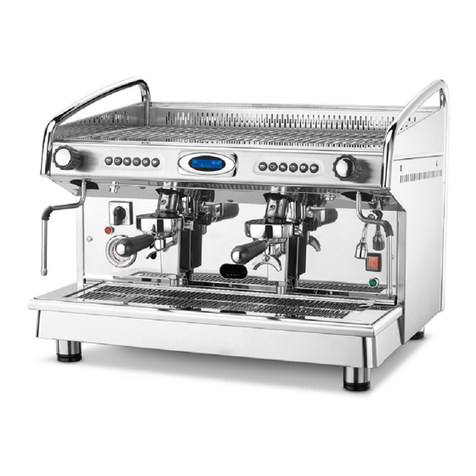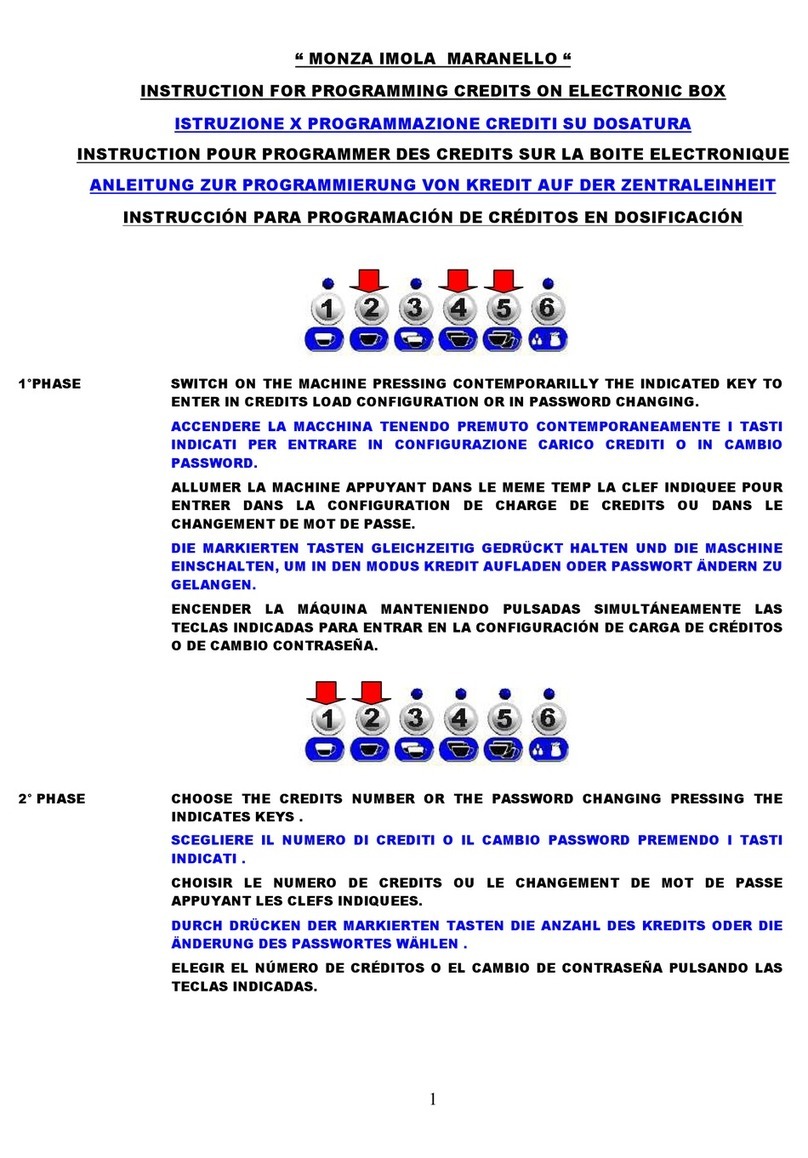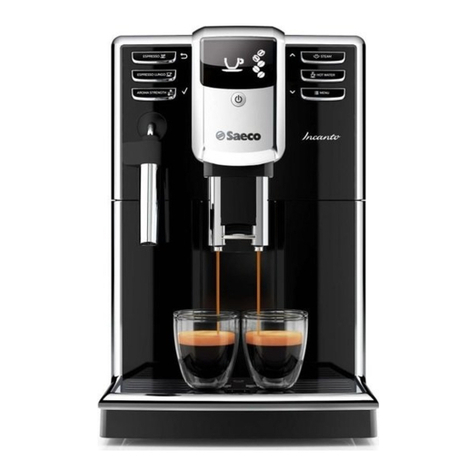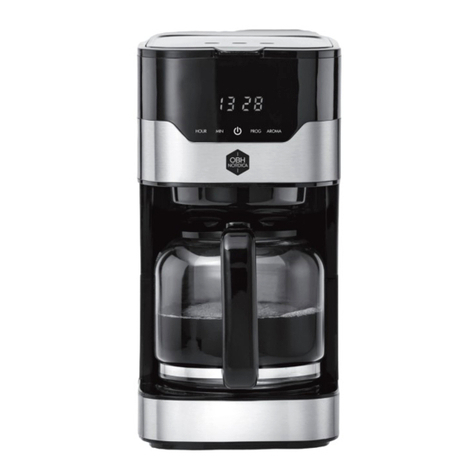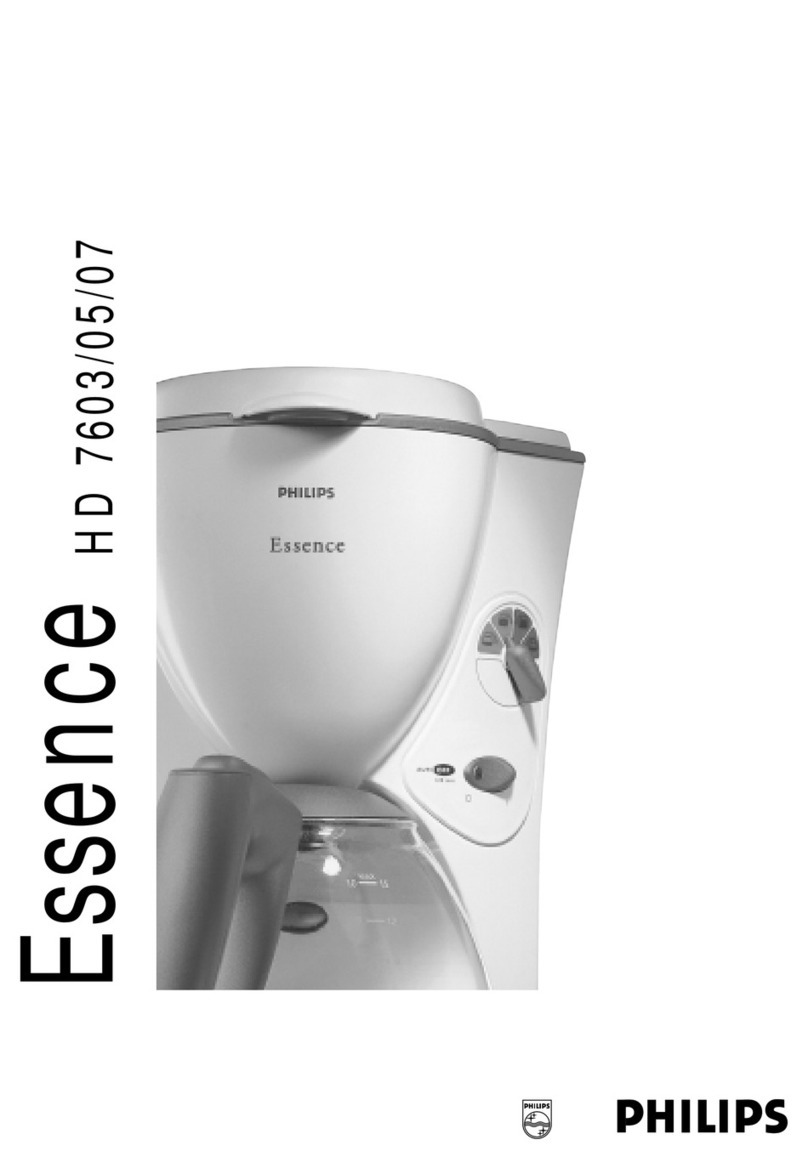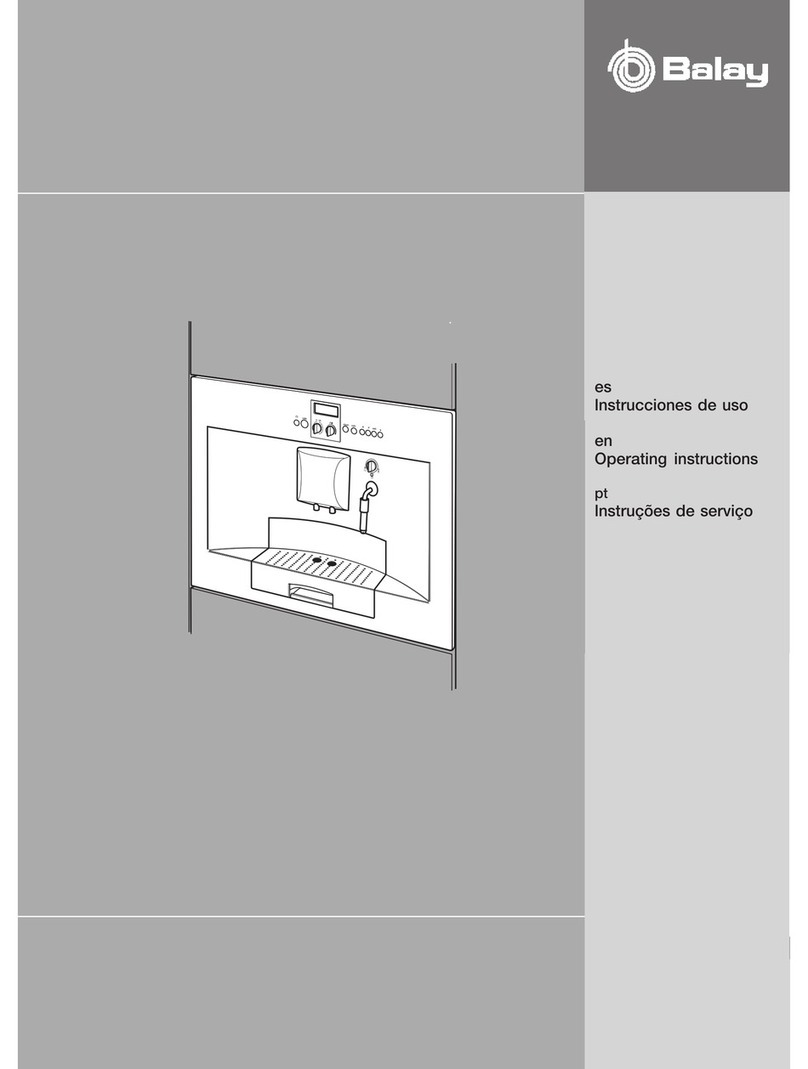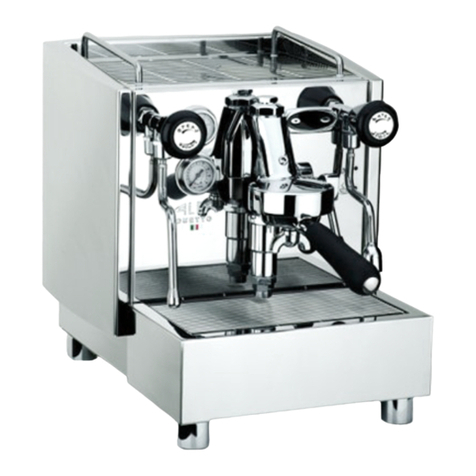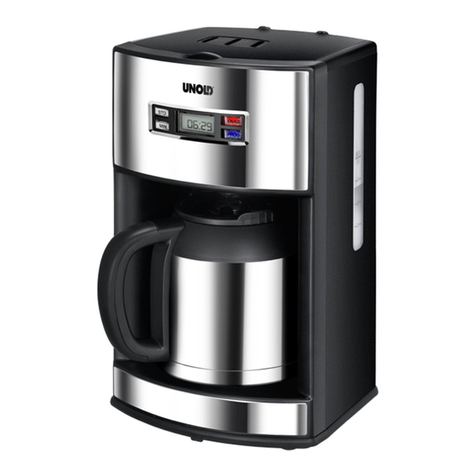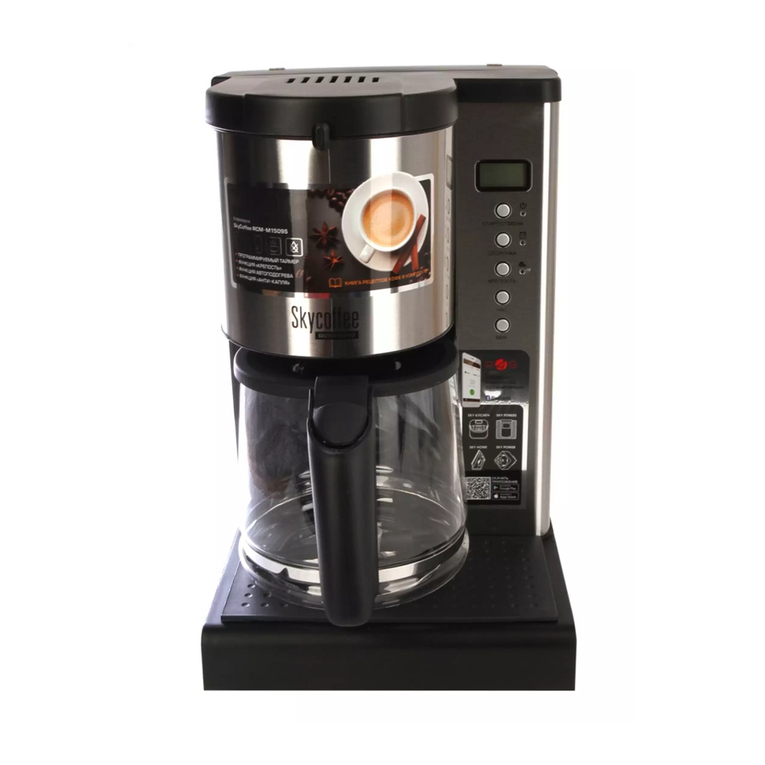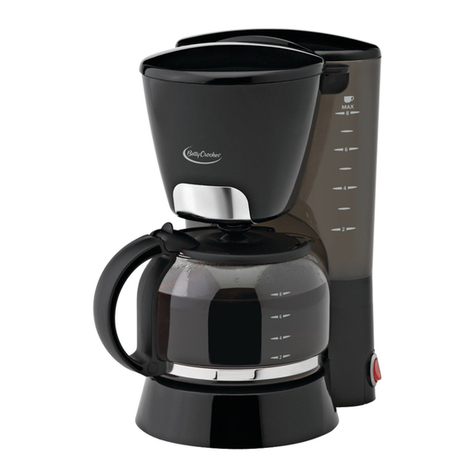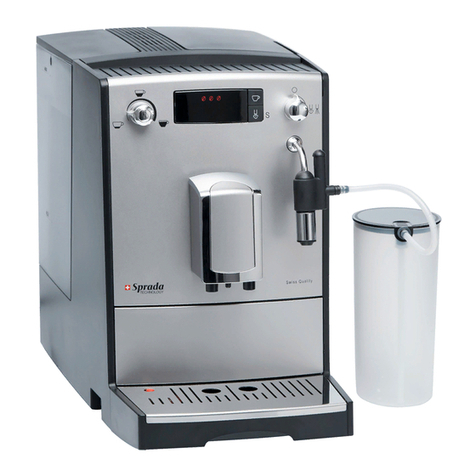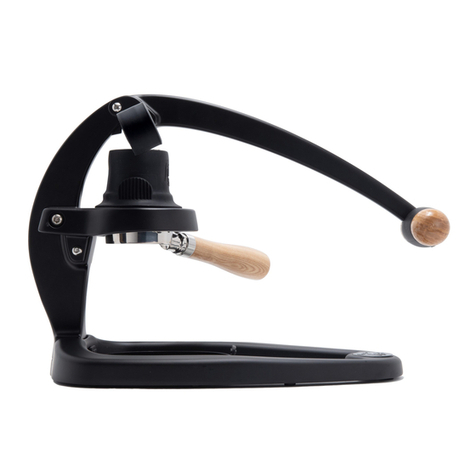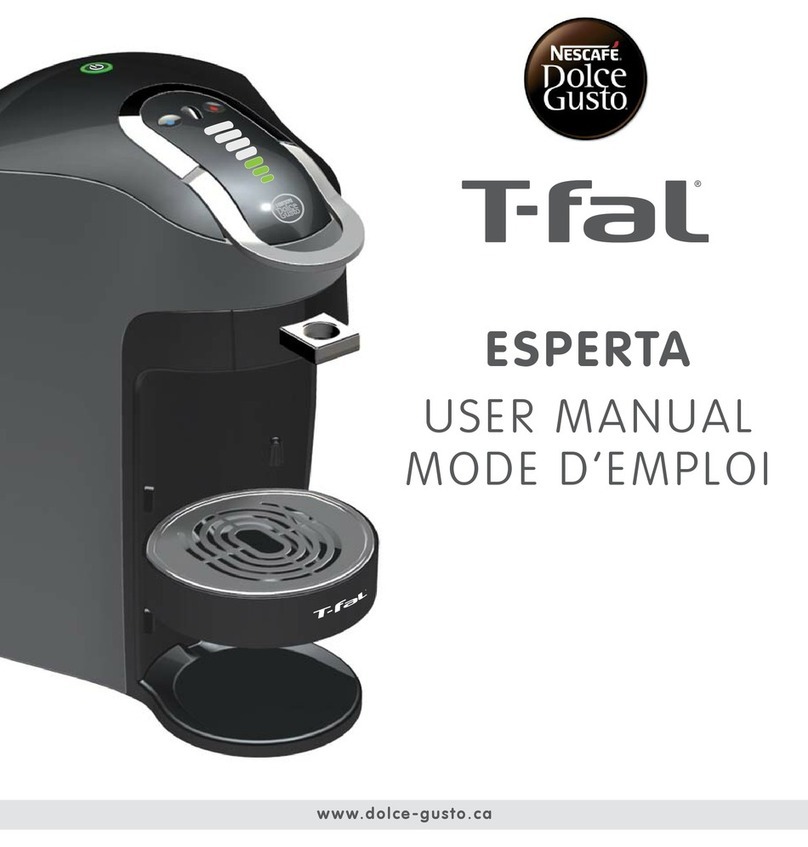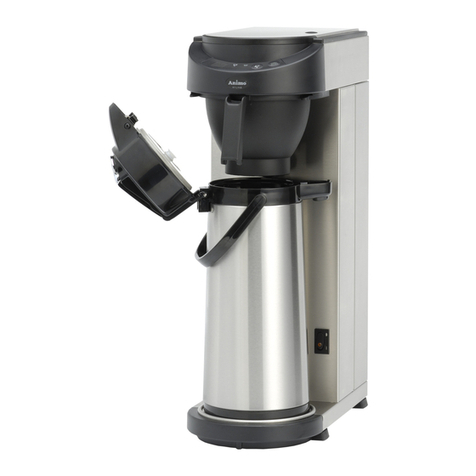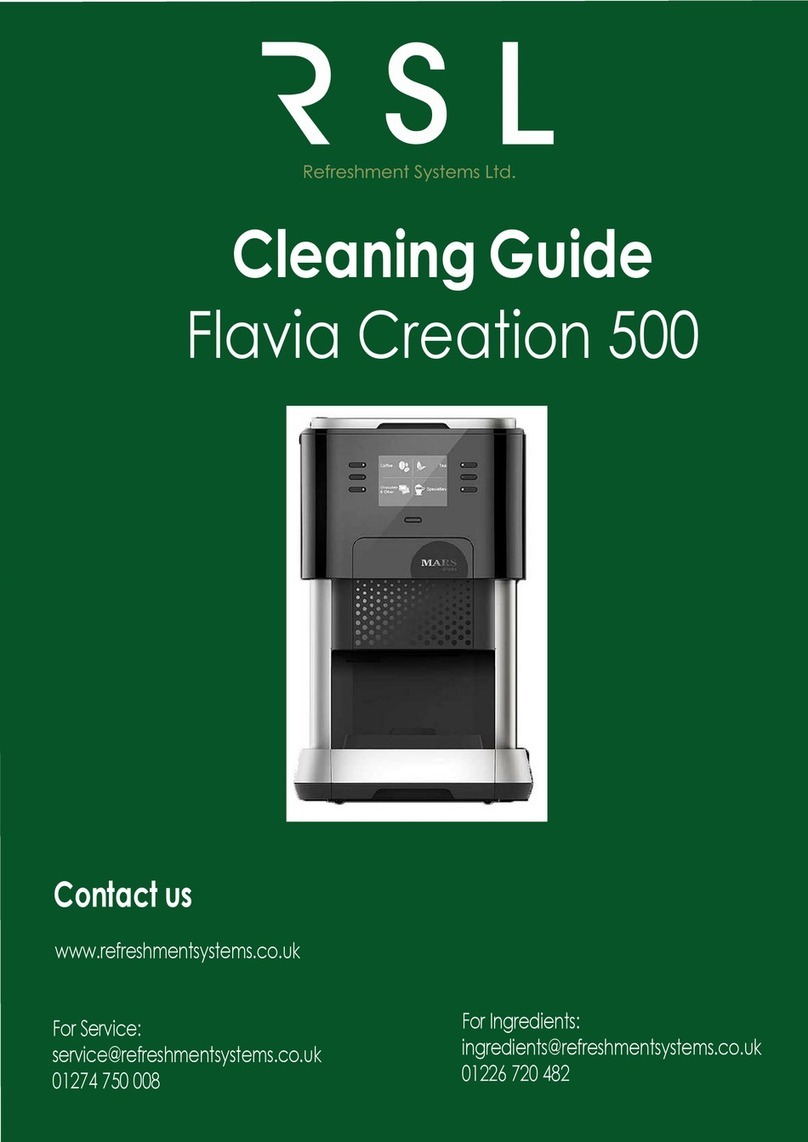BFC JUNIOR User manual

CAPPUCCINATORE NERO
BLACK CAPPUCCINO MAKER
CAPPUCCINO - SCHÄUMER SCHWARZ
ATTACCO A RETE IDRICA
DIRECT WATER CONNECT
ZUSATZ FÜR DEN DIREKTEN WASSERANSCHLUSS
ADATTATORE CIALDE
POD ADAPTER
ADAPTER FÜR KAFFEEPADS
OPTION
JUNIOR ( VJ-1L)
MANUALE DI ISTRUZIONI
INSTRUCTIONS FOR USE
BEDIENUNGSANLEITUNG
1113_Rev004

IL PRODOTTO NON PUO’ ESSERE AVVIATO ALLO SMALTI-
MENTO NEL NORMALE CICLO DI RACCOLTA RIFIUTI, MA
SMALTITO NEI CENTRI AUTORIZZATI.
THE PRODUCT CANNOT BE DISPOSED OF AS NORMAL WASTE,
BUT MUST BE TAKEN TO AN AUTHORIZED DISPOSAL CENTRE.
DAS PRODUKT DARF NICHT DEM NORMALEN ABFALLKREIS-
LAUF ZUGEFÜHRT WERDEN, SONDERN IST IN AUTORISIER-
TEN ZENTREN ZU ENTSORGEN.

INDICE /INDEX
ITALIANO ______________________________________________
Avvertenze di sicurezza
Controindicazione d’uso
Presentazione
Accessori in dotazione
Installazione
Macchina con allacciamento a rete idrica
Accensione macchina
Erogazionecaè
Erogazione vapore e acqua calda
Manutenzione
Mini addolcitore a resine
Informazioni pratiche e suggerimenti
Dichiarazione di conformità
ENGLISH ______________________________________________
Safety warnings
Precautionary measures
Introduction
Accessories supplied
Installation
Machine with connection to the mains water supply
Machine ignition
Coeedelivery
Steam and hot water delivery
Maintenance
Mini resin water softener
Practical information and suggestions
Declaration of conformity
DEUTSCH _____________________________________________
Sicherheitshinweise
Unzweckmäßiger Gebrauch
Einleitung
Mitgeliefertes Zubehör
Installation
KaeemaschinemitZusatzfür den direkten Wasseranschluss
Einschaltung der Maschine
Kaeezubereitung
Dampfausgabe und Wasserausgabe
Wartung
Mini-Enthärter
Praktische hinweise und Anregungen
Konformitätserklärung
1-8
9-16
17-25

1. AVVERTENZE DI SICUREZZA
◆Prima di collegare la macchina accertarsi che i dati di targa siano rispondenti a quelli della rete di
distribuzione elettrica. Collegare l’apparecchio solo a impianto e prese di corrente aventi portata
minimadi10Aedotatediecientemessaaterraesalvavita.
◆In caso di incompatibilità tra la presa e la spina dell’apparecchio, fare sostituire la presa con un’altra
ditipoadattodapersonaleprofessionalmentequalicato.
◆È vietato l’uso di adattatori, prese multiple e/o prolunghe.
◆Incasodidubbioodiincertezzafarcontrollaredapersonalequalicatol’impiantodialimentazione
elettrica, che deve rispondere ai requisiti disposti dalle normative di sicurezza vigenti, fra i quali:
-ecacemessaaterra;
-sezionedeiconduttorisucienteallapotenzadiassorbimento;
-dispositivosalvavitaeciente.
◆L’apparecchionondeveessereusatodabambiniodapersoneconcapacitàsiche,sensorialiomen-
tali ridotte o privi di esperienza e conoscenza dell’apparecchio, salvo che non siano sorvegliati o che
non siano stati opportunamente istruiti.
◆I bambini devono essere supervisionati per assicurarsi che non giochino con l’apparecchio.
◆Prima di qualsiasi operazione di manutenzione interna, mettere l’interruttore generale nella posizione
OFF o staccare la spina dalla presa di alimentazione. A macchina elettricamente collegata, non in-
trodurre mai le mani o altri oggetti all’interno della stessa.
◆Non esporre la macchina a intemperie o installarla in ambienti a elevata umidità come locali da
bagno ecc... Non tirare il cavo di alimentazione o l’apparecchio con mani o piedi bagnati o umidi. Non
lasciare l’apparecchio contenente acqua in ambienti a temperatura inferiore o uguale a 0°C.
La macchina non può essere installata in un ambiente all’aperto, non protetto da eventi atmosferici
o comunque con temperatura inferiore a 5 °C.
◆Durante la pulizia dell’apparecchio non immergerlo in acqua.
Non mettere mai l’apparecchio sotto il rubinetto per aggiungere l’acqua nel serbatoio.
◆Non ostruire le griglie di aspirazione o di dissipazione, in particolare non coprire con panni o altro il
piano scaldatazze.
◆L’apparecchio non deve essere spostato durante il funzionamento.
◆Utilizzaresoloaccessoriericambiautorizzatidalproduttore.Questosignicagaranziadisicurofun-
zionamento privo di inconvenienti.
◆Incasodiemergenza,comeprincipiod’incendio,rumorositàanomala,surriscaldamento,ecc...interve-
nireimmediatamenteastaccarel’alimentazioneelettricadirete,chiudereirubinettidelgasedell’acqua.
◆In caso di guasto e/o cattivo funzionamento dell’apparecchio, spegnerlo e non manometterlo. Per
eventualiriparazionirivolgersisolamenteaduncentroassistenzaautorizzatodalcostruttoreerichiede-
re l’utilizzo di ricambi originali. Il cavo di alimentazione di questo apparecchio non deve essere sosti-
tuitodall’utente.Seilcavoèdanneggiatoodeveesseresostituito,rivolgersiaduncentroautorizzato.
◆Conservare con cura questo libretto per ogni ulteriore consultazione. Per operazioni diverse da quelle
descritte in questo manuale, consultare il nostro centro assistenza.
Il mancato rispetto di queste avvertenze può compromettere la sicurezza
dell’apparecchio. Un’errata installazione puó causare danni a persone e
cose per i quali il costruttore non può considerarsi responsabile.
1
MACCHINE PER CAFFÈ ESPRESSO
MANUALE di ISTRUZIONE
Da chi le macchine le pensa, le progetta e le produce

2. CONTROINDICAZIONE D’USO
Le macchine sono destinate ad uso esclusivamente alimentare per cui é vietato l’impiego di liquidi o
materiali di altro genere che possano generare pericoli e inquinare gli erogatori.
Questoapparecchioèdestinatoall’usodomesticoeapplicazionisimili,adesempio:areediristoroper
ilpersonalediuci,negozie/oaltriambientidilavoro;aziendeagricole;utilizzodapartediclientidi
alberghi,moteloaltriambientiacarattereresidenziali;negliambientitipobedandbreakfast.
Il costruttore declina ogni responsabilità per danni a persone o cose dovuti ad uso improprio, errato o
irragionevoleeariparazionieettuatedapersonalenonqualicato.
3. PRESENTAZIONE
Questo libretto costituisce una guida rapida e semplice alla manutenzione ed uso delle macchine per
caè.Leggereattentamentequantoriportatonellesezionichecompongonoquestomanuale.
La ditta assicura, nel caso vi fossero problemi e mal funzionamenti, la sua più ampia collaborazione
tramite i suoi centri assistenza. Fate controllare almeno una volta all’anno la Vostra mac-
china per caè da personale qualicato. Questa costante attenzione, renderà la macchina più
ecienteesicura.Lemacchinesonostateprogettateecostruitenelrispettodituttelecaratteristiche
checontraddistinguonoletradizionalimacchinepercaèespressodabar:materialinobiliqualirame
eacciaioecomponentiadabili,rendonolemacchinecostruitedalladitta,sicure,adabiliefunzio-
nali.L’eventuale diverso utilizzo non contemplato nelle riportate istruzioni, solleva la ditta da qualsiasi
responsabilità per eventuali danni a persone o cose.
2
Manopola erogazione vapore
Manopola erogazione acqua calda
Interruttore generale ON/OFF
Spia rossa alimentazione
Spia verde resistenza
Lancia vapore
Lancia acqua
Levaerogazionecaè
Portaltro
Vaschetta raccogligocce
Griglia superiore portatazze
Manometro pressione caldaia (0-3 bar)
Gruppoerogatorecaè

3
Filtro una tazza Filtro cieco
Filtro due tazze 2Mollefermaltro
Baccuccio una tazza Beccuccio due tazze
Mini addolcitore Pressino
2Portaltri
Spazzolino di pulizia
Cucchiaino dosatore
4. ACCESSORI IN DOTAZIONE

5. INSTALLAZIONE
Prima di azionare l’interruttore di accensione generale ON/OFF (3) verso l’alto, si rac-
comanda di caricare con acqua la tanica posteriore posta sotto la griglia portatazze (11).
1)Toglierel’imballo,vericandoall’istantel’integritàdellamacchinaechenonabbiasubitodanni.
2) Posizionare l’apparecchio sopra un tavolo o bancone robusto ed in piano, vicino ai punti di collega-
mento elettrico ed idraulico. La macchina deve essere installata in posizione orizzontale. L’inclinazio-
ne del piano di appoggio non deve essere maggiore di 1°. Per garantire il normale esercizio, l’apparec-
chio deve essere installato in luoghi in cui la temperatura ambiente sia compresa tra una temperatura
+5°C ÷ +32°C e l’umidità non superi il 70%. Non usare getti d’acqua, né installare in luoghi dove
vengano usati getti d’acqua. Accertarsi che la tensione della rete elettrica corrisponda a quella indicata
nelle caratteristiche tecniche.
3) Togliere la griglia superiore (11), estrarre il conteni-
tore dell’acqua posto all’interno della macchina e sciac-
quarlo (Foto 1).
4) Riempire con circa 3 litri di acqua pulita la tanica,
posizionarla nuovamente nella sua sede e inserirvi i tubi
di silicone con addolcitore collegato. Richiudere la gri-
glia superiore (11) della macchina.
5) Prima della messa in funzione, l’installatore deve ve-
ricarechelamacchinasiastatacollegatacorrettamen-
teall’impiantoelettricoutilizzatoreeall’impiantoditerra,vericandol’ecienzadellaprotezionedai
contatti indiretti. In Europa collegare alla rete elettrica il cavo omologato H05VV-F 3G 1,5 mm con
spina Schuco. In Usa-Canada collegare alla rete elettrica il cavo omologato Type SJTO, rated 3x14
AWG, 300 V, 105°C con SPINA NEMA 5x15P.
È VIETATO UTILIZZARE LA MACCHINA IN ASSENZA DI UN EFFICACE E
SICURO COLLEGAMENTO DI MESSA A TERRA.
5a. MACCHINA CON ALLACCIAMENTO A RETE IDRICA
Nel caso la macchina sia stata acquistata con allacciamento a rete idrica, chiamare un tecnico spe-
cializzato. Il tecnico dovrà collegare, tramite tuboflex in dotazione (3/8’’), il raccordo di carico della
macchina al sistema di trattamento dell’acqua destinata al consumo umano (o potabile) (non previsto
in dotazione) (usare solo tubi idonei al contatto con acqua destinata al consumo umano secondo legi-
slazione del paese di utilizzo del prodotto). È necessario installare un riduttore di pressione.
Infine mettere l’addolcitore in fase di lavoro e verificare che non ci siano delle perdite.
6. ACCENSIONE MACCHINA
Prima dell’accensione della macchina, si consiglia di controllare la presenza di acqua nella
tanica posteriore posta sotto la griglia portatazze (11).
1) Azionare l’interruttore generale ON/OFF (3) verso l’alto. La spia rossa (4) si accenderà.
2) All’accensione della macchina la scheda elettronica controlla lo stato del livello di acqua in caldaia e
dopo circa 3 secondi avviene il riempimento tramite l’abilitazione della pompa e della elettrovalvola di
carico. La macchina inizierà a riempirsi di acqua automaticamente sino al raggiungimento del livello
impostato (sonda autolivello in caldaia).
NB: Le macchine con tanica interna a innesto rapido incorporano un sistema di sicurezza di livello.
Se entro 180’’ la sonda non rileva l’acqua in caldaia, parte un segnale acustico intermittente con
frequenza di ripetizione elevata. Per resettare l’allarme spegnere e riaccendere la macchina. In caso il
problema persista, verificare eventuali anomalie nella tanica e nei tubi di silicone di entrata dell’acqua.
4

5
3) Al raggiungimento del livello, la pompa si ferma. La spia verde resistenza (5) si accende e inizia il
riscaldamento dell’acqua.
Si consiglia di far uscire acqua dal gruppo di erogazione (13) per 5 secondi in modo da eliminare
eventuali bolle d’aria nel circuito termosifonico e permetterne una migliore termocompensazione.
4) Attendere circa 15-20 minuti per permettere alla macchina di raggiungere la temperatura di lavoro.
5) Lo spegnimento della spia verde (5) segnala che la macchina ha raggiunto la pressione prestabilita.
La spia rossa (4) rimarrà sempre accesa per segnare la tensione di alimentazione.
NB:Incasodiprimoutilizzomantenerelamacchinaintemperatura(senzaerogareacquaecaffè)per
circa 2 ore. Si consiglia di aprire il rubinetto dell’acqua (2) e di erogare in un bricco almeno 0,5 litri
di acqua per consentirne il recircolo. Far uscire acqua dal gruppo di erogazione (13) per 30 secondi e
aprire il rubinetto del vapore (1) per 10 secondi.
6) La mancanza di acqua nella tanica posteriore sarà avvisata da un segnale acustico. La macchina
arresterà tutte le funzioni elettriche e idrauliche, pur mantenendo la spia rossa (4) accesa.
Riempiendola di acqua, il micro interruttore o il sensore elettronico di livello della tanica riattiverà
tutte le funzioni nuovamente.
7) Il manometro (12), posto frontalmente, rileva in ogni momento la pressione interna della caldaia
(0,9-1,1 bar).
8) Visionare abbastanza frequentemente il manometro (12) per controllare la pressione in caldaia.
Lamacchinaèdotatadidispositividisicurezzacheintervengonoincasodianomalieallapressione
interna alla caldaia.
7. EROGAZIONE CAFFÈ
1)Pererogarecaèdalgruppo,dosarelagiustaquantitàdicaèMACINATOBAR(circa7grammi
pariad1cucchiainodosatore),nelportaltro(9)conuscitasingola.
2)Pressareilcaèconl’appositopressino.
3)Inserireilportaltro(9)nelgruppoerogatorecaè(13)ruotandolo
da sinistra a destra sino al bloccaggio dello stesso.
4)Posizionareunatazzasottoilportaltro(9).
5) Azionare la leva manuale (8), laterale al gruppo, verso l’alto.
6)Alraggiungimentodellaquantitàdicaèdesiderata,fermarel’e-
rogazione azionando la leva manuale (8) verso il basso.
7)Sesidesiderafarealtricaè,togliereilportaltro(9)ruotandolo
dadestraasinistraevuotareifondidicaè.Ripeterepoileopera-
zioni sopra elencate.
8)Perottenereduecaè,utilizzareilportaltro(9)adueusciteconduedosidelcucchiainodosatore.
9)Acquistandol’appositoadattatore(option),èpossibileutilizzareanchelacialdadicaèpreconfezio-
natada7grammio14grammi,rispettivamenteperunaoduetazzedicaè(Foto2).
Ricordarsidipuliresempreaccuratamenteiltrinelcambiodamacinatoacialdapreconfezionata.
Fareattenzionenellamessainfunzionedellamacchinapercaffè.Letemperatureelevate
del tubo vapore (6), del tubo acqua (7) e del gruppo erogazione cromato (13) possono
provocare scottature. Non sganciare per nessun motivo il portafiltro dal gruppo, durante
l’erogazionedelcaffè.PERICOLOSCOTTATURE.
8. EROGAZIONE VAPORE E ACQUA CALDA
1) Per erogare vapore, operare sulla manopola laterale sinistra (1).
2) Per erogare acqua calda, operare sulla manopola laterale destra (2).
Vapore ed acqua calda sono in pressione. PERICOLO USTIONI.

9. MANUTENZIONE
◆Qualsiasi manutenzione dell’apparecchio deve essereeettuatainunambienteincuilatemperatura
sia compresa tra una temperatura +5°C ÷ +32°C.
◆Con un panno pulito o carta pulita ad uso alimentare pulire la lancia del vapore dopo ogni utilizzo
per evitare le incrostazioni e l’otturazione dei fori di uscita vapore.
◆Vuotareepulireiltridelcaètuttelesere;togliereilltroepulireconl’appositospazzolinol’in-
terno;immergerliinacquacaldaalnedidissolvereigrassidelcaè.
◆Pulirelavaschettaraccogligoccedaresiduidelcaèchesivannodepositandosulfondoperevitarne
l’incrostazione.
◆Conl’appositoltrociecoindotazione,eseguireillavaggiodelgruppoerogazioneutilizzandoun
specicodetergente(darichiedereainostricentriassistenza).Procederecomesegue:
1-Inserireilltrocieconelportaltroeaggiungereildetergentesecondoledosiindicatenellaconfezione.
2-Inserireilportaltronelgruppoerogatore.
3- Accendere l’erogazione per 10 secondi. Fermare per 10 secondi. Ripetere per 5 volte.
Dell’acqua mista a schiuma uscirà dalla valvola di scarico dentro la vaschetta raccogligocce.
4-Rimuovereilportaltro.Accenderel’erogazioneerisciacquareilportaltroconl’acquacaldache
esce dal gruppo erogatore. Fermare l’erogazione.
5-Inserireilportaltronelgruppoerogatore.Perrisciacquareripetereilpunto3senzadetergente.
6-Sostituireilltrocieconelportaltroconilltrocorrettoefareunespressodaeliminare.
◆Le parti esterne della macchina devono essere pulite con un panno umido e non utilizzare mai de-
tersivi o sostanze abrasive. Non pulire la macchina con getti d’acqua.
◆Perpulireilportaltroedicestellidelltro,preparareinuncontenitorediplasticaoacciaioinox
una soluzione con acqua calda e detergente, ed immergerli nella soluzione per almeno 30 minuti.
Sciacquarliconacquapulita.Unafrequentepuliziaconsentiràdiottenereuncaèdolce,oltreapro-
lungareladuratadellavostramacchinapercaè.
6

7
◆Non utilizzare mai accessori metallici, spugne metalliche o abrasivi per la pulizia del portafiltro.
◆Verificare periodicamente il buono stato dei componenti d’uso comune (portafiltri, filtri, guarnizioni,
doccette). Richiedere i componenti originali ad un centro assistenza.
10. MINI ADDOLCITORE A RESINE
◆Calcio e magnesio determinano la durezza dell’acqua e provocano la formazione di quello che noi
chiamiamosemplicementecalcare.Da30°f a40°f l’acquaèdura;da40°f insuèconsideratamolto
dura. La misurazione avviene tramite appositi semplici test che si possono acquistare presso qualsiasi
centro assistenza.
◆All’internodelserbatoioimmersoinacqua,sitrovaunpiccoloaddolcitorearesine(unoèanchein
dotazione), che va sostituito o rigenerato ogni 20-30 litri di acqua utilizzata.
La rigenerazione avviene immergendo il piccolo addolcitore in una soluzione di acqua e sale da cucina
(un cucchiaio - NaCl Cloruro di sodio) per un tempo di circa 48 ore. Sciacquare con acqua pulita più
volte e riposizionare il piccolo addolcitore, collegato al tubo di silicone, all’interno del serbatoio.
11. INFORMAZIONI PRATICHE E SUGGERIMENTI
Si raccomanda una durezza dell’acqua compresa tra 15 e 30 gradi francesi
(vericare con il proprio centro assistenza). In presenza di un valore inferiore o
superiore ai parametri consigliati, sono necessari dei controlli periodici e una apposita
pulizia dei circuiti idraulici da parte di tecnici specializzati.
Infunzionedelluogogeogracoediuneventualeperiododiinattività,siraccomandano
dellepuliziespecichedelcircuitoidraulicodapartedipersonalequalicato.
◆Perottenereilmassimorisultatodoveteutilizzarecaèmacinatoadusobar,corrispondenteaduna
grossezzadimacinaturabendenita.AlvostroTorrefattoreonegoziopertantooltrelavostramiscela
preferita darete questa indicazione di macinatura.
◆Acquistandol’appositoadattatore(option),èpossibileutilizzareanchelacialdadicaèpreconfe-
zionata.L’usodel caffè incialdaoffriràmoltivantaggi: lalibertàdi sceltatralenumerosemarche
presenti sul mercato, un espresso costantemente buono indipendentemente dalla esperienza di chi
preparailcaffè,unaestremafacilitàd’uso,edinfineunaminormanutenzioneinquantolamacchina
resta costantemente pulita.
◆Pergustareunottimocaè:
-acquistareunabuonamisceladicaèingrani.
-conservareilcaèingraniinunluogoasciutto.
-macinareilcaèingranituttelevoltechesidesiderauncaè.
- dosare e pressare leggermente la macinatura per renderla più omogenea.
◆Perottenereuncaèbollente:
-lasciaresempreinseritoilportaltro,conrelativoltrovuoto,nelgruppoerogatorecaè.
-sciaquareilportaltroedilltroconacquabollentepremendol’interruttorecaè.
- con la stessa acqua bollente pre-riscaldare le tazze.
◆Per ottenere un buon cappuccino:
- utilizzare un recipiente alto e stretto riempito per circa metà di latte.
- immergere la lancia vapore per 1 cm.
- aprire il rubinetto vapore con la manopola.
◆Per scaldare solamente il latte:
- immergere la lancia vapore sino in fondo al recipiente.
- aprire il rubinetto vapore con la manopola.
- chiudere il rubinetto vapore una volta raggiunta la temperatura desiderata.

8
DICHIARAZIONE DI CONFORMITÀ
Prodotto : Macchinepercaèespresso
Modello : 1 GR VJ-1L
B.F.C. srl dichiara sotto la propria responsabilità, che il prodotto soddisfa per progettazione e costru-
zione i requisiti della direttiva:
1) DIRETTIVA BASSA TENSIONE
2014/35/UE (ex 2006/95/CE)
Laconformitàèstatavericataconl’ausiliodelleseguentinormearmonizzate:
EN 60335-1 / EN 60335-2-15 / EN 60335-1 (EN 62233)
2) DIRETTIVA COMPATIBILITA’ ELETTROMAGNETICA
2014/30/UE (ex 2004/108/CE)
Laconformitàèstatavericataconl’ausiliodelleseguentinormearmonizzate:
EN 55014-1 / EN 55014-1 (EN 61000-3-2) / EN 55014-1 (EN 61000-3-3)
EN 55014-2 (EN 61000-4-2) / EN 55014-2 (EN 61000-4-4) / EN 55014-2 (EN 61000-4-5)
EN 55014-2 (EN 61000-4-11) / EN 55014-2 (EN 61000-4-6) / EN 55014-2 (EN 61000-4-3)
◆2011/65/UE (ex 2002/95/CE RoHS)
2002/96/CE RoHS
2003/108/CE RoHS
Sulla base delle nostre conoscenze, i nostri fornitori di materiali non utilizzano nella fabbricazione
dei loro prodotti, le sostanze pericolose che sono elencate nelle Direttive CEE sopramenzionate.
◆REGOLAMENTO (CE) N. 1935/2004 DEL PARLAMENTO EUROPEO E DEL
CONSIGLIO del 27 ottobre 2004 riguardante i materiali e gli oggetti destinati a venire a
contatto con i prodotti alimentari.
◆REGOLAMENTO (CE) N. 2023/2006 DELLA COMMISSIONE del 22 dicembre
2006 sulle buone pratiche di fabbricazione dei materiali e degli oggetti destinati a venire
a contatto con prodotti alimentari.
◆REGOLAMENTO (UE) N. 10/2011 DELLA COMMISSIONE del 14 gennaio 2011
riguardante i materiali e gli oggetti di materia plastica destinati a venire a contatto con i
prodotti alimentari.
◆Decreto Ministeriale del 21/03/1973, Disciplina igienica degli imballaggi, recipienti,
utensili, destinati a venire in contatto con le sostanze alimentari o con sostanze d’uso
personale.
◆Metals and alloys used in food contact materials and articles, European Directorate for
the Quality of Medicines & HealthCare of the Council of Europe (EDQM), Council of
Europe, 2013.
◆UNI EN 16889:2016
Igiene degli alimenti - Produzione ed erogazione di bevande calde da apparecchi per bevande calde
- Requisiti di igiene, prove di migrazione.
L’amministratore delegato
Brutti Marco

ESPRESSO COFFEE MACHINES
INSTRUCTIONS for USE
9
1. SAFETY WARNINGS
◆Check that the data on the machine corresponds to that of the electrical supply network, before
connectingtheequipment.Onlyconnecttheappliancetoanecientlyearthedpowersockethaving
aminimumcapacityof 10A,andttedwithanRCD.
◆If theplugsuppliedisunsuitableforyourpowersocket,havetheplugreplacedbyaqualiedelec-
trician.
◆Adaptors, multiple sockets and /or extensionsmust not be used.
◆ When in doubt, request a detailed diagram of the supplied power from a qualied electrician.
The power supply must be provided with the following safety devices:
-ecientearthingconnection;
-sectionof conductorssuitableforabsorptioncapacity;
-ecientearthingleakageprotectioncircuitbreaker.
◆The appliance is not to be used by children or persons with reduced physical, sensory or mental capa-
bilities, or lack of experience and knowledge, unless they have been given supervision or instruction.
◆Children should be supervised to ensure that they do not play with the appliance.
◆AlwayspressthemainswitchtoOFFordisconnectthecoeemachinefromthemainsbeforeany
internal maintenance. Never put your hands or any object into the machine when it is connected
to the mains.
◆Do not leave the machine exposed to environmental elements or place them in damp rooms such
as bathrooms... Do not touch the power cord or the appliances when hands or feet are wet or damp.
Do not leave water inside the appliance in environments where the temperature is equal to or less
than 0°C. The machine must not be installed in an outdoor setting, in a place not protected from
weathering or in any case at a temperature below 5°C.
◆Do not immerse the appliance in water when cleaning it.
Never add water to the tank by putting the appliance under the tap.
◆Do not obstruct the suction or dispersion grilles and do not cover with cloths, etc.
◆The appliance must not be moved while in operation.
◆Only use original spare parts in order to avoid compromising the safety and proper functioning of
the machine.
◆Inanemergency,suchasre,unusualnoise,overheating,etc.,takeimmediateaction,disconnectthe
power and close gas and water taps.
◆ If the appliance does not seem to be working correctly, switch it o and do not tamper with
it. Return it only to an aftersales service centre authorised by the manufacturer for repair and request
original spare parts.
The power cord of this appliance must not be replaced by the user. If the cord is damaged or needs
to be replaced, take it to an authorised after-sales service only.
◆Carefully keep this booklet for future reference. Contact our Repair Service for any maintenance
thatisnotdescribedinthisleaet.
Failure to comply with these warnings could jeopardise the safety of the
appliance. Improper installation can cause damage to people, animals and
things for which the manufacturer cannot be considered responsible.
Devised, designed and produced by us

10
2. PRECAUTIONARY MEASURES
Thismachinemayonlybeusedwithfoodstus.Itcannotbeusedforliquidsoranyother kind of
product that could damage and pollute it.
Thisapplianceisintendedtobeusedinhouseholdandsimilarapplicationssuchas:stakitchenareas
inshops,ocesandotherworkingenvironments;farmhouses;byclientsinhotels,motelsandother
residentialtypeenvironments;bedandbreakfasttypeenvironments.
The manufacturer cannot be held responsible for damage to people or things caused by unsuitable,
erroneous or irrational use and by unauthorised repair.
3. INTRODUCTION
Thisbookletisaguidetorapidandeasyuseandmaintenanceof coeemachines.
Please read these instructions carefully. The company garantees that should any defect or problem
occur, it will provide its support through its Repair Service points.
Have your coee machine inspected by qualied personnel at least once a year. This con-
stantcarewillmakeyourmachinesaferandmoreecient.Ourcoeemachineshavebeendesigned
and manufacured in complicance with all specications that distinguish traditional espresso coee
machines: noble materials such as copper and steel and reliable components make alla machines made
by the company safe, reliable and funciontal. No liability can be accepted by the company for any
damage to persons or things caused by non-compliance with these instructions.
Steam knob
Hot water knob
ON/OFF Power switch
Power on red indicator light
Heating element operation green indicator light
Steam nozzle
Hot water nozzle
Coeedispensinglever
Filter holder
Drip tray
Upper cover grid
Boiler pressure gauge (0-3 bar)
Coeedistributionunit

11
4. ACCESSORIES SUPPLIED
One-cuplter Blindlter
Two-cupslter 2 Filter - retaining springs
One - cup spout Two - cups spout
Mini water softener Coeetamper
2 Filter holders
Cleaning brush
Measuring spoon

12
5. INSTALLATION
BeforeliftingthemainON/OFFswitch(3)lltherearwatertankunderthecupshelf
(11).
1)Removethecoeemachinefromitsparckingandcheckthatithasnotbeendamaged.
2) Place the appliance on a stable top, close to the mains sockets and water line connections. The
machine must be installed in a horizontal position. The inclination of the support surface must not
be greater than 1°. To ensure normal operation, the machine must be installed in places where the
ambient temperature is between +5°C and +32°C and humidity does not exceed 70%. Do not use
water jets or install in places where water jets are used. Check that the voltage of your mains supply
correspondstothatindicatedinthetechnicalspecications.
3) Remove the upper cover grid (11), take out the water
tank (located inside the machine) and rinse it (Photo 1).
4) Fill the tank with approx. 3 litres clean water, put it
back, connect the water softener and insert the small
silicone tubes. Close the upper cover grid (11) on the
machine.
5) Before start-up the tter must make sure the ma-
chine has been properly connected to the electrical and
earthingsystemsinvolvedand checktheeciency of
protection from direct contact.
In Europe connect the approved cord H05VV-F 3G 1.5 mm with the Schuko plug to the electricity
supply.
In USA-Canada connect the approved cord Type SJTO, rated 3x14 AWG, 300 V, 105°C with the
NEMA 5x15P plug to the electricity supply.
IT IS STRICTLY FORBIDDEN TO USE THE MACHINE WITHOUT EFFEC-
TIVE SAFE EARTHING.
5a. MACHINE WITH CONNECTION TO THE MAINS
WATER SUPPLY
If your machine is to be connected to the mains water supply call a specialized technician. Using the
suppliedtuboex(3/8”),thetechnicianwillconnectthemachinellingconnectortothesystemused
to treat water intended for human consumption (or potable) (not provided) (use only tubes suitable for
contact with water intended for human consumption in accordance with legislation in the country
where the product is used). A pressure reducer must be installed. Switch on the water softener and
check for any leaks.
6. MACHINE IGNITION
Before turning on the machine it is advisable that you check that there is water inside the
rear tank under the cup shelf (11).
1) Lift the ON/OFF power switch (3). The red indicator light (4) comes on.
2) When the machine is switched on, the electronic card checks water level inside the boiler. After
approx.3seconds,thellingpumpandsolenoidvalveareenabledforlling.
The coffee machine will automatically be filled with water up to the pre-set level (level probe inside
the boiler).
NB: The machines with internal tank quick coupling incorporate a safety system level. If the probe
doesnotdetectwaterintheboilerwithin180”,itstartsthesoundof abuzzerwithhighrepetition

13
rate. To reset the alarm turn the machine off then on again. If the problem remains, check for any
abnormalities into the tank or in the water inlet silicon pipes.
3) When the set level is reached, the pump stops. The green warning light (5) comes on and the heating
element starts heating the water.
It is advisable that you dispense water (13) for 5 seconds so as to eliminate any air bubbles from the
thermosyphon circuit and for better thermal compensation.
4) Wait approximately 15-20 minutes to allow the machine to reach its operating temperature.
5) When the green warning light (5) goes out the set machine pressure has been reached. The red
indicator light (4) will be always light (tension on the electrical circuit).
NB: If being used for the first time, maintain the machine temperature (without dispensing water and
coffee) for about 2 hours. It is advisable that you let the water circulate through the system: turn the
waterknob(2)andllajugwithatleast0.5litreswater.Dispensewater(13)for30secondsandturn
the steam knob (1) for 10 seconds.
6) If there is no water in the rear tank, it will be signaled by a beep. All the electrical and water func-
tions of the machine will stop, while the red indicator light (4) remains on.
Upon filling the tank with water, the micro switch or the electronic lever sensor in the tank will re-ac-
tivate all the functions.
7) Pressure gauge (12) on the front show internal boiler pressure (0.9-1.1 bar) at all times.
8) Look at the pressure gauge (12) fairly frequently to check the boiler pressure. The appliance is fitted
with a safety device, which trips if the pressure inside the boiler is abnormal.
7. COFFEE DELIVERY
1) Tomakecoee,puttherightamountof BARGROUNDcoee(approx.7gramsequivalentto1
measuringspoon)intothe1-cuplterholder(9).
2)Pressthecoeewiththecoeetamper.
3)Fitthelterholder(9)inthecoeedistributionunit(13)andtwist
from left to right to block it in place.
4)Placeonecupunderthelterholder(9).
5) Lift the manual lever (8) on the side of the unit.
6)Whenthedesiredquantityof coeehasbeendispensedlowerthe
lever(8)tocutodelivery.
7)If youwanttomakemorecoeeremovethelterholder(9)by
turning it from right to left and empty out the used grounds. Repeat
the above operations.
8)Toobtain2coees,usethe2-cuplterholder(9)withtwomeasuringspoonfuls.
9)If theoptionaladapteristted,youcanalsousepre-packagedcoeepods(7gror14gr),which
makeonecupandtwocupsof coeerespectively(Photo2).
Alwaysremembertocleantheltersthoroughlywhenchangingfromgroundtopodcoee.
Take care when using the coffee maker. The high temperatures of the steam nozzle (6), hot
water nozzle (7) and chromed filtering unit (13) could cause burns.
Under no circumstances remove the filter holder from the filtering head during dispensing
of coffee. DANGER OF SCALDING.
8. STEAM AND HOT WATER DELIVERY
1) To dispense steam, use the knob to the side left (1).
2) To dispense hot water, use the knob to the side right (2).
Steam and water are under pressure. SCALD HAZARD.

9. MAINTENANCE
◆Any maintenance must be carried out in an environment where the temperature is between +5°C
and +32°C.
◆Using a clean cloth or food-grade paper, clean the steam wand after each use to prevent the forma-
tion of scaling and the clogging of the steam outlet holes.
◆Emptyandcleanthecoeelterseveryevening;removethelterandbrushtheinsidewithasuita-
blebrush;soaktheltersinhotwaterinordertodissolvecoeegreases.
◆Cleanthedriptrayof residuesof coeeonthebottomtopreventencrustation.
◆The power cord of this appliance must not be replaced by the user. If the cord is damaged or needs
to be replaced, take it to an authorised after-sales service only. Proceed as follows:
1-Inserttheblindlterinthelterholderandaddtheamountof detergentindicatedonthepack.
2-Insertthelterholderintothegrouphead.
3- Start brew cycle for 10 seconds and stop for 10 seconds. Repeat this operation for 5 times.
Mixedwaterandfoamwillowoutthedrainvalveintothedriptray.
4-Removethelterholderfromgrouphead.Start brewcycleandrinse thelterholderwiththe
boiling water from group head. Stop cycle.
5-Insertthelterholderintogroupheadandrepeatstep3torinsewithoutdetergent.
6-Replacetheblindlterinthelterholderwiththecorrectlterandmakeanddiscardanespresso.
◆Clean the external parts of the machine with a damp cloth. Never use detergents or abrasive sub-
stances. Do not use jets of water to clean the machine.
◆Tocleanthelterholderandthelters,leavethemtosoakforatleast30minutesinasolutionof
hot water and detergent prepared in a plastic or stainless steel container. Rinse them with clean water.
Frequentcleaningallowsasmoothcoeetobeobtainedaswellasprolongingthelifeof yourcoee
maker.
14

◆Neverusemetalaccessories,wireorabrasivespongestocleanthelterhousing.
◆Periodically checkthatthe parts subjecttowearareintact(lterhousing, lters,gaskets,shower
heads). Order original parts to a customer support centre.
10. MINI RESIN WATER SOFTENER
◆Calcium and magnesium determine the hardness of the water and cause the formation of what we
simplycallscale.Waterishardfrom30°f to40°f;itisconsideredveryhardfrom40°f upwards.The
hardness can be measured by simple test kits, which may be purchased at any service centre.
◆There is a small resin water softener (plus one in the accessories kit) inside the water tank, which
should be replaced or regenerated once every 20-30 litres of water that are used.
The small water softener can be regenerated by putting it in salt water (0,5 litres and one spoonful of
NaCl, sodium chloride) for approx. 48 hours. Thoroughly rinse with clean water and put the small
water softener connected to the silicone tube back inside the tank.
11. PRACTICAL INFORMATION AND SUGGESTIONS
We recommend water hardness between 15 and 30 French degrees (check
with your help centre). If the value is greater than or less than the recommended
parameters, periodic checks and a special cleaning of the hydraulic circuits by specialized
technicians are required.
Depending on the geographical location and a possible period of inactivity, it’s recom-
mendedaspeciccleaningof thehydrauliccircuitbyqualiedpersonnel.
◆Forbestresults,usegroundcoeeforbaruse,whichhasawell-denedcoarsenessof grinding.Give
thisgrindingindicationtoyourcoeeroasterorshopwhenaskingforyourfavouriteblend.
◆If theoptionaladapteristted,youcanalsousepre-packagedcoeepods.Theuseof coffeepods
offers many advantages: the freedom to choose from among the many brands on the market, a con-
stantly good espresso irrespective of the experience of whoever is making it, extremely easy to use and
lastly, less maintenance because the appliance remains constantly clean.
◆Toenjoyexcellentcoee:
-purchaseagoodbrandof coeeinbeans.
-keepthecoeeinbeansinadryplace.
-grindthecoeebeansfreshwhenyoumakecoee.
-measureandpressthegroundcofeslightlytopackitmoreuniformly.
◆Forboilinghotcofe:
-leavethelterholderwiththeemptyemptylterinthecoeedistributionunitatalltimes.
-rinsethelterholderandlterwithboilinghotwaterbypressingthecoeeswitch.
- use the same boiling water to pre-heat the cups.
◆For a delicious cappuccino:
- use a tall narrow milk pitcher half full.
- immerse the steam nozzle 1 cm into the milk.
- open the steam tap with the knob.
◆If you just want to heat the milk:
- immerse the steam nozzle all the way into the milk.
- open the steam tap with the knob.
- close the steam tap when the milk is hot enough.
15

16
DECLARATION OF CONFORMITY
Product : Espressocoeemachines
Types : 1 GR VJ-1L
B.F.C. srl declare here with on our own responsability that the above - metioned product meets the
requirements of the Directive:
1) LOW VOLTAGE DIRECTIVE
2014/35/UE (ex 2006/95/CE)
Confromity has been controlled with the aid of the following harmonized standards:
EN 60335-1 / EN 60335-2-15 / EN 60335-1 (EN 62233)
2) ELECTROMAGNETIC COMPATIBILITY
2014/30/UE (ex 2004/108/CE)
Confromity has been controlled with the aid of the following harmonized standards:
EN 55014-1 / EN 55014-1 (EN 61000-3-2) / EN 55014-1 (EN 61000-3-3)
EN 55014-2 (EN 61000-4-2) / EN 55014-2 (EN 61000-4-4) / EN 55014-2 (EN 61000-4-5)
EN 55014-2 (EN 61000-4-11) / EN 55014-2 (EN 61000-4-6) / EN 55014-2 (EN 61000-4-3)
◆2011/65/UE (ex 2002/95/CE RoHS)
2002/96/CE RoHS
2003/108/CE RoHS
To the best of our knowledge, our material suppliers do not use in the manufacturer of their prod-
ucts the hazardous substances which are listed in the above mentioned EU Directives.
◆REGULATION (EC) No. 1935/2004 OF THE EUROPEAN PARLIAMENT AND
COUNCIL of 27th October 2004 regulating materials and articles intended to come into
contact with food.
◆COMMISSION REGULATION (EC) No. 2023/2006 of 22nd December 2006 on good
manufacturing practices for materials and articles intended to come into contact with
food.
◆COMMISSION REGULATION (EU) No. 10/2011 of 14th January 2011 on plastic
materials and articles intended to come into contact with food.
◆Ministerial Decree of 21/03/1973, concerning the hygiene requirements of packages,
containers and tools intended to come into contact with food or substances for personal
use.
◆Metals and alloys used in food contact materials and articles, European Directorate for
the Quality of Medicines & HealthCare of the Council of Europe (EDQM), Council of
Europe, 2013.
◆UNI EN 16889:2016
Food hygiene - Production and dispense of hot beverages from hot beverage appliances - Hygiene
requirements, migration test.
CEO
Brutti Marco

ESPRESSOMASCHINEN
BEDIENUNGSANLEITUNG
17
1. SICHERHEITSHINWEISE
◆Vor Anschluss der Espressomaschine überzeugen Sie sich bitte davon, dass die auf dem Typenschild
angegebenen Daten mit denen des am Aufstellungsort verfügbaren Stromnetzes übereinstimmen.
Das Gerät nur an eine Netzsteckdose anschließen, welche eine Mindeststromstärke von 10A besitzt,
und mit einer funktionstüchtigen Erdung ausgerüstet und einem Schutzschalter abgesichert ist.
◆Sollten Steckdose und Gerätestecker nicht zusammenpassen, ist der Gerätestecker nur von Fach-
personal gegen einen anderen Typ auszutauschen.
◆Der Einsatz von Adaptern, Mehrfachsteckdosen und/oder Verlängerungskabeln ist nicht zulässig.
◆Im Zweifelsfall die elektrische Anlage von einem Fachmann überprüfen lassen. Die Anlage muss den
gültigen Sicherheitsvorschriften entsprechen, diese umfassen unter anderem:
-Sicherheitserdung;
-einenfürdieLeistungangemessenenKabeldurchmesser;
- Schutzschalter.
◆DieMaschinedarf nichtvonKindernodervonGeistigbeeinträchtigtenPersonen,diedieMaschinenicht
kennen,bedientwerden;esseidenn,dassdiesunterAufsichtodernachvorherigerEinweisungerfolgt.
◆Bitte Kinder beaufsichtigen, damit sie nicht mit dem Gerät spielen.
◆Vor Beginn jeglicher Wartungsarbeit im Innern der Espressomaschine den Hauptschalter auf Position
OFF stellen oder den Netzstecker ziehen. Ist das Gerät an das Stromnetz angeschlossen, nie die
Hände oder leitende Gegenstände ins Geräteinnere bringen.
◆DieEspressomaschinekeinenWitterungseinüssenaussetzenundnichtinfeuchtenRäumenwie
z.B. Badezimmer, etc., installieren. Das Netzkabel des Geräts nicht mit nassen oder feuchten Händen
oder Füssen aus der Steckdose ziehen. Das mit Wasser befüllte Gerät vor Frost schützen (Tempera-
turenunterodergleich0°C).DieMaschinedarf nichtimFreien,nichtgegenWitterungseinüsse
geschützt installiert und bei Temperaturen unter 5 °C betrieben werden.
◆Das Gerät zum Reinigen nicht in Wasser tauchen.
Das Gerät zum Füllen des Tanks mit Wasser niemals unter einen Wasserhahn stellen.
◆ Die Belüftungsgitter nicht verstopfen und die Oberäche, die zur Erwärmung der Kaeetassen
gedacht ist, nicht mit Tüchern oder anderem abdecken.
◆Das Gerät darf während des Betriebs nicht bewegt werden.
◆Zum Austausch von defekten Teilen nur vom Hersteller zulässige Ersatzteile verwenden. Dies
gewährleistet die Funktionstüchtigkeit ohne Störungen.
◆Im Störungsfall, falls die Espressomaschine Feuer fangen sollte, merkwürdige Geräusche macht,
sichüberhitzt,etc.,sofortdenNetzsteckerziehenundeventuellinderNähebendlicheGas-und
Wasserhähne abdrehen.
◆Im Falle von Störungen und/oder fehlerhafter Funktion das Gerät ausschalten und nicht ma-
nipulieren. Für eventuelle Reparaturen wenden Sie sich bitte ausschließlich an ein autorisiertes
Kundendienstzentrum des Herstellers und verlangen den Einsatz von Originalersatzteilen. Sollte
das Netzkabel des Geräts beschädigt sein oder ausgetauscht werden müssen, darf dies nicht durch
den Benutzer erfolgen. Wenden Sie sich an ein autorisiertes Kundendienstzentrum.
◆Diese Bedienungsanleitung als Referenz sorgfältig aufbewahren. Sollen andere, als die hier be-
schriebenen Vorgänge ausgeführt werden, wenden Sie sich an eine unserer Kundendienststellen.
Die Nichtbeachtung dieser Sicherheitshinweise beeinträchtigt die Gerätesi-
cherheit. Eine nicht fachgerechte Installation kann zu Personen- und Sach-
schäden führen, für die der Hersteller keine Haftung übernehmen kann.
This manual suits for next models
1
Table of contents
Languages:
Other BFC Coffee Maker manuals
